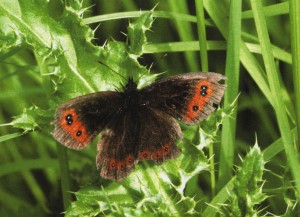 This will be a good summer to look for butterflies as there are a number of exciting trends taking place. One of the advantages of watching butterflies is that unlike other insects, say moths, there are not very many species and most of them are readily identified. The list for the UK is around 72 butterflies that regularly occur there. Of these around 33, including the annual migrants, occur in the Highlands. Another advantage, apart from identification, is that butterflies can be seen in a wide variety of places. Gardens are an obvious one and many gardeners, apart from catering for other wildlife such as birds and to a lesser extent mammals, often plant with butterflies in mind. Butterflies are now synonymous with many gardeners as there are a number of books and booklets dealing with the subject. Well over fifty wild flowers and shrubs are now available to gardeners to provide nectar sources for adult butterflies.
This will be a good summer to look for butterflies as there are a number of exciting trends taking place. One of the advantages of watching butterflies is that unlike other insects, say moths, there are not very many species and most of them are readily identified. The list for the UK is around 72 butterflies that regularly occur there. Of these around 33, including the annual migrants, occur in the Highlands. Another advantage, apart from identification, is that butterflies can be seen in a wide variety of places. Gardens are an obvious one and many gardeners, apart from catering for other wildlife such as birds and to a lesser extent mammals, often plant with butterflies in mind. Butterflies are now synonymous with many gardeners as there are a number of books and booklets dealing with the subject. Well over fifty wild flowers and shrubs are now available to gardeners to provide nectar sources for adult butterflies.
Buddleias may be the obvious choice for many gardeners and most plant catalogues simply call them “butterfly bushes”. The sight of a Buddleia shrub covered with blossoms with butterflies, such a red admirals, small tortoiseshells and peacocks on them, is very moving and rewarding. The secret with these nectar sources is to plan to supply blossoms for much of the spring and summer and the Autumn. At this time of the year, for example, good nectar sources are the wide variety of heathers. Most of mine are in tubs and have been in flower for some weeks and have already attracted small tortoiseshells on sunny, warm days. Other people have also recorded peacocks at the same nectar source. You can get Buddleias to flower for the Summer and Autumn but other plants are also useful such as chives, Sedums, lavender and scabious. Most gardeners do not plant to provide the foodplants of the caterpillars but some of the more attractive butterflies use the common stinging nettles. Some gardeners even leave a small patch of these tucked away in a corner. Butterflies that use them include the small tortoiseshell, red admiral and peacock.
For the last few years, for some unknown reason or reasons that are still open to great debate, a number of butterflies have spread from their southern haunts into the Highlands . This has been the subject of much publicity and recording by the leading butterfly conservation body “Butterfly Conservation”. One of the butterflies is the speckled wood as in the last few years this attractive but rather secretive woodland butterfly has spread north particularly along the east coast. There have even been an occasional record from the north coast. Another more recent newcomer on the scene, but just as intriguing, is the comma. This large, attractive butterfly is unmistakable because of the unusual jagged outline of the wings. It is called the comma because of the tiny white mark on the underside of the hind wings that really looks like a comma.
Another butterfly that has spread is the attractive orange tip whose males are unmistakable with, as the name suggests, orange tips to the two forewings. Butterfly Conservation had a special survey of this butterfly a few years ago and involved schools with great success. Other butterflies that are spreading include the purple hairstreak, ringlet and possibly even the wall. Apart from gardens even roadside verges attract a number of butterflies and one is the rare and localised Scotch argus. I like to see them fluttering along the roadsides in Strathnairn. There are some “hotspots” for butterflies and one of the outstanding ones is the sand dunes just to the east of Nairn. Other good sites include Loch Affric, Glen Strathfarrar and Loch Fleet – good hunting this summer.
